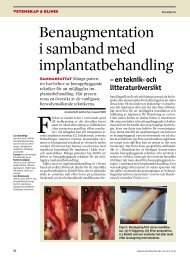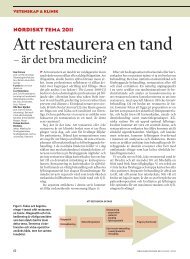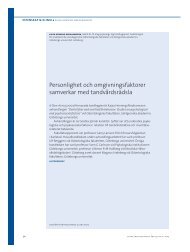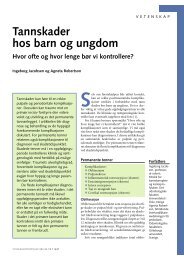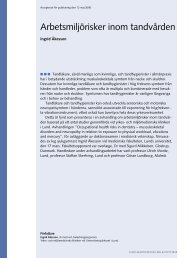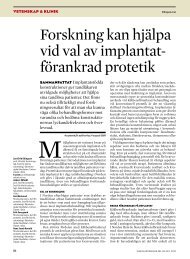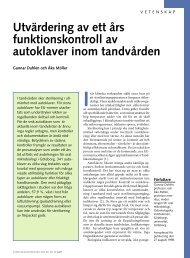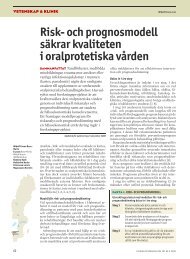Från bettet till sinnet - Tandläkartidningen
Från bettet till sinnet - Tandläkartidningen
Från bettet till sinnet - Tandläkartidningen
Create successful ePaper yourself
Turn your PDF publications into a flip-book with our unique Google optimized e-Paper software.
VETENSKAP & KLINIK<br />
Hälsoekonomi Käkledsbesvär<br />
i tandvården<br />
patienterna den största vinsten genom att skyddas<br />
mot olämplig behandling.<br />
KONKLUSION: Blicken måste flyttas från <strong>bettet</strong><br />
<strong>till</strong> <strong>sinnet</strong>.<br />
ENGLISH SUMMARY<br />
From bite to mind<br />
Carl Molin<br />
<strong>Tandläkartidningen</strong> 2006; 98 (13): 54–61<br />
One of the most controversial fields in dentistry<br />
has been the temporomandibular disorder<br />
syndrome (TMD). The otologist James B. Costen<br />
published 1934 a paper: A syndrome of ear and<br />
sinus symtoms depending upon disturbed<br />
function of the temporomandibular joint, that<br />
directed the focus to the bite. As the dentists<br />
had the capacity for treating the supposed<br />
cause: a lowered or disturbed bite, the responsability<br />
went from medicine to dentistry. The<br />
bite or occlusal concept was widely accepted<br />
even to the exten that such disturbances could<br />
provoke mental disturbances. Bite-rising and<br />
equilibration were performed on a large scale.<br />
A totally new and scientifically founded paradigm<br />
was brought about at Columbia University<br />
in New York by the general practitioner Laszlo<br />
Schwartz in the middle of the fifties. After his<br />
death his pupil Joseph J Marbach has carried<br />
on an uncompromising fight against evidenceless<br />
treatment.<br />
In Chicago Charles Greene and Daniel Laskin<br />
founded a TMJ Research center with a psychophysiological<br />
approach.<br />
An even wider scope concerning pain was<br />
adopted at University of Washington. Influenced<br />
by the work of John Bonica, Samuel<br />
Dworkin and Linda LeResche have developed<br />
a bio-psychosocial system for diagnoses and<br />
treatment of TMD.<br />
By now, the most active and promising<br />
research is performed at University of North<br />
Carolina in Richmond studying the genetic<br />
ground for pain sensivity and chronicity due<br />
to variants of an enzyme, COMT, that regulates<br />
the level of neurotransmittors: adrenalin, noradrenalin<br />
and dopamin.<br />
The paper, furthermore, presents both a<br />
theory for the origin of muscle pain and a<br />
comparison of human oral parafunctions with<br />
similar habits, so called stereotypes, in cattle.<br />
REFERENSER<br />
1. Stohler C. Taking stock: from<br />
chasing occlusal contacts to<br />
vulnerability alleles. Clin<br />
Orthodont Res 2004; 7 (3):<br />
157–61.<br />
4. Dworkin S, LeResche L.<br />
Research diagnostic criteria<br />
for temporomandibular<br />
disorders: Review, criteria,<br />
examinations and specifications,<br />
critique. J Craniomandib<br />
Disord Facial Oral<br />
Pain 1992; 6: 301–55.<br />
6. Molin C. Etiologi och terapi<br />
vid så kallade käkledsbesvär<br />
<strong>Tandläkartidningen</strong> 1967;<br />
59: 389–405, 85–99.<br />
10. Holmlund A, Eriksson L,<br />
Svenson B, Adell R. Käkledskirurgi<br />
— artroskopisk,<br />
öppen och rekonstruktiv.<br />
<strong>Tandläkartidningen</strong> 1996;<br />
88: 1115–25.<br />
14. National Institute of Health<br />
Technology. Assessment<br />
Conference statement:<br />
Management of Temporomandibular<br />
Disorders. 29<br />
April–1 May 1996. Oral Surg<br />
Oral Med Oral Pathol Oral<br />
Radiol Endod 1997; 83:<br />
177–83.<br />
16. Schwartz LL. Disorders of<br />
the Temporomandibular<br />
Joint. Philadelphia: WB<br />
Saunders; 1959.<br />
18. Costen JB. A syndrome of<br />
ear and sinus symptoms<br />
dependent upon disturbed<br />
function of the temporomandibular<br />
joint. Ann Otol<br />
1934; 43: 1–15.<br />
20. Göthe C-J, Molin C, Nilsson<br />
C. The environmental somatization<br />
syndrome: Review<br />
article. Psychosomatics<br />
1995; 36: 1–11.<br />
22. Ericsson S, Riise C. Muskulär<br />
hyperaktivitet. In: Krogh-<br />
Poulsen W, Carlsen O (eds).<br />
Bidfunktion Bettfysiologi II<br />
Patofunktion Copenhagen:<br />
Munksgaard; 1974: 315–28.<br />
27. Marbach JJ. Laszlo Schwartz<br />
and the origins of clinical<br />
research in TMJ disorders.<br />
NY State Dent J 1991:<br />
38–41.<br />
31. Laskin DM. Etiology of the<br />
pain-dysfunction syndrome.<br />
J Am Dent Assoc 1969; 79:<br />
147–53.<br />
39. Ramfjord SR. Bruxism, a<br />
clinical and electromyographic<br />
study. J Am Dent<br />
Assoc 1961; 62: 21–44.<br />
46. Redbo I. Stereotypies in<br />
dairy cattle and their<br />
relation to confinement.<br />
Production-related factors,<br />
physiological reactions,<br />
and adjoining behaviours<br />
(thesis). Uppsala, Sweden:<br />
Swedish university of agricultural<br />
sciences, 1992.<br />
48. Glaros A, Glass E, McLaughlin<br />
L. Knowledge och beliefs<br />
of dentists regarding temporomandibular<br />
disorders<br />
and chronic pain. J Orofac<br />
Pain 1994; 8: 216–22.<br />
67. Milner-Brown H, Stein R,<br />
Yemm R. The orderly recruitment<br />
of human motor units<br />
during volontary isometric<br />
contractions. J Physiol<br />
(Lond) 1973; 230: 359–70.<br />
70. Hägg G, editor. Static work<br />
load and occupational<br />
myalgia – A new explanation<br />
model. In: Anderson P,<br />
Hubard D, Danoff (eds).<br />
Electromyographical<br />
Kinesiology. Amsterdam:<br />
Elsevier Science; 1991:<br />
141–4.<br />
71. Thorn S, Forsman M, Zhang<br />
Q, K T. Low-threshold motor<br />
unit activity during a 1-h<br />
static contraction in the<br />
trapezius muscle. Int J Ind<br />
Erg 2002; 30: 225–36.<br />
77. Clark EN. Occlusion and<br />
myofascial pain dysfunction:<br />
Is there a relationship?<br />
J Am Dent Assoc 1982;<br />
104: 443–6.<br />
80. Zarb G, Carlsson G, Rugh J.<br />
Clinical management. In:<br />
Zarb G, Carlsson G, Sessle B,<br />
Mohl N (eds). Temporomandibular<br />
joint and masticatory<br />
muscle disorders, ed 2.<br />
Copenhagen: Munksgaard;<br />
1994: 529-48.<br />
85. Greene C. The etiology of<br />
temporomandibular disorders:<br />
implications for<br />
treatment. J Orofac Pain<br />
2001; 15: 93–105.<br />
90. Loeser J, Egan K. Managing<br />
the chronic pain patient:<br />
Theory and practice at the<br />
university of Washington<br />
multidisciplinary pain<br />
center. New York: Raven;<br />
1989.<br />
93. Dworkin S. The dentist as<br />
biobehavioral clinician. J<br />
Dent Educ 2001; 65 (12):<br />
1417–29.<br />
94. Maixner W, Fillingim R,<br />
Sigurdsson A, Kincaid S,<br />
Silva S. Sensitivity of patients<br />
with painful temporomandibular<br />
disorders to<br />
experimentally evoked pain:<br />
evidence for altered temporal<br />
summation of pain. Pain<br />
1998; 76 (1–2): 71–81.<br />
95. Zubieta J-K, Heitzeg MM,<br />
Smith YR, Bueller JA, Xu K,<br />
X0 Y et al. COMT val158met<br />
genotype affects mu-opioid<br />
neurotransmitter responses<br />
to a pain stressor. Science<br />
2003; 299 (5610): 1240–3.<br />
96. Diatchenko L, Slade G,<br />
Nackley A, Bhalang K,<br />
Sigurdsson A, Belfer I, et al.<br />
Genetic basis for individual<br />
variations in pain perception<br />
and the development of<br />
a chronic pain condition.<br />
Hum Mol Genet 2005; 14<br />
(1): 135–43.<br />
TANDLÄKARTIDNINGEN ÅRG 98 NR 13 2006<br />
61



